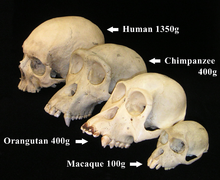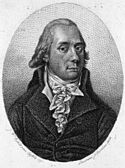형질인류학
위키백과, 우리 모두의 백과사전.

영장류의 머리뼈. 인간, 침팬지, 오랑우탄, 마카크
형질인류학(形質人類學), 혹은 자연인류학(自然人類學)이라고도 불리는 이 학문은 인간의 행동 및 생물학적 양상, 인간과 관련된 영장류 그리고 멸종한 인류의 조상들에 대해 연구한다. 인류학의 하위 분과로서는 계통학적 인류 연구에 대한 생물학적 견해를 보여주는 역할을 담당한다.
분과[편집]
형질인류학은 몇 가지 하위 분과를 가지고 있다.
고인류학에서는 인류 진화의 증거가 되는 화석들을 연구한다. 고인류학에서는 멸종한 인류와 다른 영장류들에 대한 연구를 통해 인류 진화의 환경적 배경을 탐구한다.
영장류학에서는 영장류의 행동양상, 형태, 그리고 유전자에 대해서 연구한다. 인간과 영장류의 상동성과 유사성에 대한 연구를 통해 인류의 특성이 왜 그렇게 발전해 왔는지에 대해 알 수 있다.
환경생태학에서는 진화학적-환경학적 관점에서 수렵 채집, 재생산, 개체 발생 등과 같은 행태적 적응 양상에 대해 연구한다.
인간생물학은 생물학과 형질인류학, 영양학과 의학이 합쳐진 영역이며 전지구적 관점에서의 건강, 진화, 해부학, 생리학, 적응, 집단 유전학에 대해 탐구한다.
생고고학(生考古學)에서는 고고학적 자료들을 통해 인류 문화의 종적을 탐구한다. 고고학적 자료란 이를테면 연조직이 포함된 뼈 화석등을 말한다. 생고고학 연구자들은 인체 골 해부학, 고인류병리학, 고고학들을 총체적으로 연구한다.
고인류병리학은 고대의 질병들에 대해 연구하는 학문이다. 고인류병리학에서는 뼈 화석이나 미라화된 연조직에서만 관찰 가능한 병인(病因)뿐만 아니라 영양장애, 시간에 따른 형태의 변화, 신체적 외상, 생체역학적 부상에 대한 단서 등에 대해서도 연구한다.
법인류학이란 골 해부학, 고인류병리학, 고고학, 그리고 여러 인류학적 분과들의 종합학문으로 사망 사건에 대한 재구성을 목표로 한다.
Biological anthropology
 |
| Anthropology |
|---|
 |
Biological anthropology, also known as physical anthropology, is a scientific discipline concerned with the biological and behavioral aspects of human beings, their extinct hominin ancestors, and related non-human primates, particularly from an evolutionary perspective.[1] This subfield of anthropology systematically studies human beings from a biological perspective.
Branches[edit]
As a subfield of anthropology, biological anthropology itself is further divided into several branches. All branches are united in their common orientation and/or application of evolutionary theory to understanding human biology and behavior.
- Bioarchaeology is the study of past human cultures through examination of human remains recovered in an archaeological context. The examined human remains usually are limited to bones but may include preserved soft tissue. Researchers in bioarchaeology combine the skill sets of human osteology, paleopathology, and archaeology, and often consider the cultural and mortuary context of the remains.
- Evolutionary biology is the study of the evolutionary processes that produced the diversity of life on Earth, starting from a single common ancestor. These processes include natural selection, common descent, and speciation.
- Evolutionary psychology is the study of psychological structures from a modern evolutionary perspective. It seeks to identify which human psychological traits are evolved adaptations – that is, the functional products of natural selection or sexual selection in human evolution.
- Forensic anthropology is the application of the science of physical anthropology and human osteology in a legal setting, most often in criminal cases where the victim's remains are in the advanced stages of decomposition.
- Human behavioral ecology is the study of behavioral adaptations (foraging, reproduction, ontogeny) from the evolutionary and ecologic perspectives (see behavioral ecology). It focuses on human adaptive responses (physiological, developmental, genetic) to environmental stresses.
- Human biology is an interdisciplinary field of biology, biological anthropology, nutrition and medicine, which concerns international, population-level perspectives on health, evolution, anatomy, physiology, molecular biology, neuroscience, and genetics.
- Paleoanthropology is the study of fossil evidence for human evolution, mainly using remains from extinct hominin and other primate species to determine the morphological and behavioral changes in the human lineage, as well as the environment in which human evolution occurred.
- Paleopathology is the study of disease in antiquity. This study focuses not only on pathogenic conditions observable in bones or mummified soft tissue, but also on nutritional disorders, variation in stature or morphology of bones over time, evidence of physical trauma, or evidence of occupationally derived biomechanic stress.
- Primatology is the study of non-human primate behavior, morphology, and genetics. Primatologists use phylogenetic methods to infer which traits humans share with other primates and which are human-specific adaptations.
History[edit]
Origins[edit]
Biological Anthropology looks different today than it did even twenty years ago. The name is even relatively new, having been 'physical anthropology' for over a century, with some practitioners still applying that term.[2] Biological anthropologists look back to the work of Charles Darwin as a major foundation for what they do today. However, if one traces the intellectual genealogy and the culture back to physical anthropology's beginnings—going further back than the existence of much of what we know now as the hominin fossil record—then history focuses in on the field's interest in human biological variation. Some editors, see below, have rooted the field even deeper than formal science.
Attempts to study and classify human beings as living organisms date back to ancient Greece. The Greek philosopher Plato (c. 428–c. 347 BC) placed humans on the scala naturae, which included all things, from inanimate objects at the bottom to deities at the top.[3] This became the main system through which scholars thought about nature for the next roughly 2,000 years.[3] Plato's student Aristotle (c. 384–322 BC) observed in his History of Animals that human beings are the only animals to walk upright[3] and argued, in line with his teleological view of nature, that humans have buttocks and no tails in order to give them a cushy place to sit when they are tired of standing.[3] He explained regional variations in human features as the result of different climates.[3] He also wrote about physiognomy, an idea derived from writings in the Hippocratic Corpus.[3] Scientific physical anthropology began in the 17th to 18th centuries with the study of racial classification (Georgius Hornius, François Bernier, Carl Linnaeus, Johann Friedrich Blumenbach).[4]
The first prominent physical anthropologist, the German physician Johann Friedrich Blumenbach (1752–1840) of Göttingen, amassed a large collection of human skulls (Decas craniorum, published during 1790–1828), from which he argued for the division of humankind into five major races (termed Caucasian, Mongolian, Aethiopian, Malayan and American).[5] In the 19th century, French physical anthropologists, led by Paul Broca (1824-1880), focused on craniometry[6] while the German tradition, led by Rudolf Virchow (1821–1902), emphasized the influence of environment and disease upon the human body.[7]
In the 1830s and 1840s, physical anthropology was prominent in the debate about slavery, with the scientific, monogenist works of the British abolitionist James Cowles Prichard (1786–1848) opposing[8] those of the American polygenist Samuel George Morton (1799–1851).[9]
In the late 19th century, German-American anthropologist Franz Boas (1858-1942) strongly impacted biological anthropology by emphasizing the influence of culture and experience on the human form. His research showed that head shape was malleable to environmental and nutritional factors rather than a stable "racial" trait.[10] However, scientific racism still persisted in biological anthropology, with prominent figures such as Earnest Hooton and Aleš Hrdlička promoting theories of racial superiority[11] and a European origin of modern humans.[12]
"New Physical Anthropology"[edit]
In 1951 Sherwood Washburn, a former student of Hooton, introduced a "new physical anthropology."[13] He changed the focus from racial typology to concentrate upon the study of human evolution, moving away from classification towards evolutionary process. Anthropology expanded to include paleoanthropology and primatology.[14] The 20th century also saw the modern synthesis in biology: the reconciling of Charles Darwin’s theory of evolution and Gregor Mendel’s research on heredity. Advances in the understanding of the molecular structure of DNA and the development of chronological dating methods opened doors to understanding human variation, both past and present, more accurately and in much greater detail.
Notable biological anthropologists[edit]
- Zeresenay Alemseged
- John Lawrence Angel
- George J. Armelagos
- William M. Bass
- Caroline Bond Day
- Jane E. Buikstra
- William Montague Cobb
- Carleton S. Coon
- Robert Corruccini
- Raymond Dart
- Egon Freiherr von Eickstedt
- Linda Fedigan
- A. Roberto Frisancho
- Jane Goodall
- Earnest Hooton
- Aleš Hrdlička
- Sarah Blaffer Hrdy
- Anténor Firmin
- Dian Fossey
- Birute Galdikas
- Richard Lynch Garner
- Colin Groves
- Yohannes Haile-Selassie
- Ralph Holloway
- William W. Howells
- Donald Johanson
- Robert Jurmain
- Melvin Konner
- Louis Leakey
- Mary Leakey
- Richard Leakey
- Frank B. Livingstone
- Owen Lovejoy
- Jonathan M. Marks
- Robert D. Martin
- Russell Mittermeier
- Desmond Morris
- Douglas W. Owsley
- David Pilbeam
- Kathy Reichs
- Alice Roberts
- Pardis Sabeti
- Robert Sapolsky
- Eugenie C. Scott
- Meredith Small
- Phillip V. Tobias
- Douglas H. Ubelaker
- Sherwood Washburn
- David Watts
- Tim White
- Milford H. Wolpoff
- Richard Wrangham
- Teuku Jacob
- Biraja Sankar Guha
See also[edit]
References[edit]
- ^ Jurmain, R, et al (2015), Introduction to Physical Anthropology, Belmont, CA: Cengage Learning.
- ^ Ellison, Peter T. (2018). "The evolution of physical anthropology". American Journal of Physical Anthropology. 165.4: 615-625. 2018.
- ^ a b c d e f Spencer, Frank (1997). "Aristotle (384–322 BC)". In Spencer, Frank (ed.). History of Physical Anthropology. 1. New York City, New York and London, England: Garland Publishing. pp. 107–108. ISBN 978-0-8153-0490-6.
- ^ Marks, J. (1995) Human Biodiversity: Genes, Race, and History. New York: Aldine de Gruyter.
- ^ "The Blumenbach Skull Collection at the Centre of Anatomy, University Medical Centre Göttingen". University of Goettingen. Retrieved February 12, 2017.
- ^ "Memoir of Paul Broca". The Journal of the Anthropological Institute of Great Britain and Ireland. 10: 242–261. 1881. JSTOR 2841526.
- ^ "Rudolf Carl Virchow facts, information, pictures". Encyclopedia.com. Retrieved February 12, 2017.
- ^ Gail E. Husch (2000). Something Coming: Apocalyptic Expectation and Mid-nineteenth-century American painting - by Gail E. Husch - ...the same inward and mental nature is to be recognized in all the races of men. ISBN 9781584650065. Retrieved February 12, 2017.
- ^ "Exploring U.S. History The Debate Over Slavery, Excerpts from Samuel George Morton, Crania Americana". RRCHNM. Archived from the original on December 11, 2016. Retrieved February 12, 2017.
- ^ Moore, Jerry D. (2009). "Franz Boas: Culture in Context". Visions of Culture: an Introduction to Anthropological Theories and Theorists. Walnut Creek, California: Altamira. pp. 33–46.
- ^ American Anthropological Association. "Eugenics and Physical Anthropology." 2007. August 7, 2007.
- ^ Bones of contention, controversies in the search for human origins, Roger Lewin, p. 89
- ^ Washburn, S. L. (1951) “The New Physical Anthropology”, Transactions of the New York Academy of Sciences, Series II, 13:298–304.
- ^ Haraway, D. (1988) “Remodelling the Human Way of Life: Sherwood Washburn and the New Physical Anthropology, 1950–1980”, in Bones, Bodies, Behavior: Essays on Biological Anthropology, of the History of Anthropology, v.5, G. Stocking, ed., Madison, Wisc., University of Wisconsin Press, pp. 205–259.
Further reading[edit]
- Michael A. Little and Kenneth A.R. Kennedy, eds. Histories of American Physical Anthropology in the Twentieth Century, (Lexington Books; 2010); 259 pages; essays on the field from the late 19th to the late 20th century; topics include Sherwood L. Washburn (1911–2000) and the "new physical anthropology"
- Brown, Ryan A and Armelagos, George, "Apportionment of Racial Diversity: A Review", Evolutionary Anthropology 10:34–40 2001
- Modern Human Variation: Models of Classification
- Redman, Samuel J. Bone Rooms: From Scientific Racism to Human Prehistory in Museums. Cambridge: Harvard University Press. 2016.
External links[edit]
| Look up phylogeny in Wiktionary, the free dictionary. |
- American Association of Physical Anthropologists [1]
- British Association of Biological Anthropologists and Osteoarchaeologists
- Human Biology Association
- Canadian Association for Physical Anthropology
- Homo erectus and Homo neanderthalensis reconstructions – Electronic articles published by the Division of Anthropology, American Museum of Natural History.
- Istituto Italiano di Antropologia
- Journal of Anthropological Sciences – free full text review articles available
- Mapping Transdisciplinarity in Anthropology pdf
- Fundamental Theory of Human Sciences ppt
- American Journal of Human Biology
- Human Biology, The International Journal of Population Genetics and Anthropology
- Economics and Human Biology
- Laboratory for Human Biology Research at Northwestern University
- The Program in Human Biology at Stanford
- Academic Genealogical Tree of Physical Anthropologists[permanent dead link]


